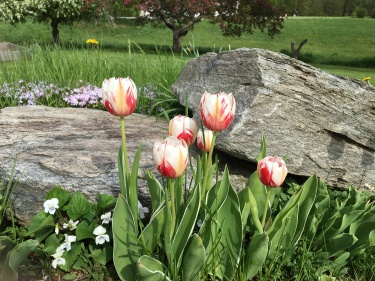By Susan Dreyer Leon
“Are you awake, Charlotte?” he said softly.
“Yes,” came the answer.
“What is that nifty little thing? Did you make it?”
“I did indeed,” replied Charlotte in a weak voice.
“Is it a plaything?”
“Plaything? I should say not. It is my egg sac, my magnum opus.”
“I don’t know what a magnum opus is,” said Wilbur.
“That’s Latin,” explained Charlotte. “It means ‘great work.’ This egg sac is my great work — the finest thing I have ever made.”
“What’s inside it?” asked Wilbur. “Eggs?”
“Five hundred and fourteen of them,” she replied.
from Charlotte’s Web by E.B. White.
I’m sitting in the lovely kitchen of my daughter’s reading tutor. This gifted woman is painstakingly leading my ten year old dyslexic child through the alphabet one handmade clay letter at a time, guiding her ability to concentrate and focus on the shapes that want to twist and twirl in her mind’s eye. I am in theory doing my own work around the corner from them, but often I am listening to their conversations. “Have you read Charlotte’s Web”? the tutor asks. “No,” says Rosie. I listen with an itch in my gut, wanting to run around the corner and blurt out. “Of COURSE you’ve read Charlotte’s Web! You’ve listened to the audio book a dozen times AND seen the movie six times AND seen a children’s play just last summer!!” But my daughter is content to allow the tutor to explain to her a little bit about the story and why she might like it. For some reason, my daughter doesn’t really respond well to direct questions. You can imagine how this is a problem in formal educational settings where question and answer remains the primary method educators use to check for understanding (well…really for memory). I fight the urge to set the record straight, to tell the tutor as we are leaving, “I don’t know why she said that. She knows all about Charlotte’s Web.” I hold my tongue.
In the car on the way home I ask Rosie. “Why did you say you’ve never read Charlotte’s Web?” She doesn’t have an answer either. And I wonder, not for the first time, what my daughter actually understands from the audio books she listens to by the hour. I think she understands a lot, but it’s not always clear and she can almost never describe that understanding in a way that is satisfying to adults (teachers and parents included). I am reminded of John Holt, the advocate for “de-schooling,” who said that it was nobody’s business but the child’s what they had learned.
Part of me believes this, but on a practical level our school system is built on children showing grown-ups how they are smart. Kids with disabilities often don’t show their intelligence in the expected pattern or way. Schools are fast- moving places and answers like my daughter’s often lead adults to conclude they aren’t “smart” and therefore are not worth teaching. Educators have sometimes told me that they think certain material is “over my daughter’s head.” Part of me trusts that she’s totally fine. She’s taking what she needs from life and will be able to make her contribution in turn. On other days I feel so anxious for my child and her future in the educational system, which is a gatekeeper for so many of modern life’s opportunities. If she doesn’t want to play the “game of school,” as Rob Fried has called it, will she be relegated to menial work rather than the kind of creative life I wish for her? I haven’t found much to be “over her head,” but I know why other adults think so. They can’t tune in to her frequency and they don’t have to time to see how quickly she makes connections between complex ideas. She says, “no” and they move on to the next thing, missing vital information and insight into her thinking. I don’t fault them, really. The conditions of their work often do not allow an individualized response to every child and many children spend their days at school unseen and unknown to the often well-intentioned but overburdened adults around them.

A few days later I am working the garden, trying to level my bird bath. I’m brushing layers of bark mulch and dirt from one side of the flower bed to the other and I turn up a perfectly round, white pebble-shaped object. At the time I say to myself, that might be an egg sac, but I think it is best just to rebury it whatever it is. I get the birdbath the way I want it and run back and forth for the hose and some flowers. All of a sudden I notice a huge spider on the rock next to the birdbath. She’s truly enormous by New England standards, half the size of my palm. And I know. I just KNOW that the little white sphere was her egg sac. It is so clear to me that she’s trying to tell me something by her presence. She is very directly asking me to help her. So I take down the bird bath and paw gently through the loose soil and bark until I find the little orb. I pop it up on the rock next to the spider. She rushes over to it and clasps it to her chest in her front four legs. She just holds it for a while. Then she pushes it off the rock and jumps off after it. It takes her a little fussing around on the ground to find it again. Then she squats over it winding silk from her body until it is bound tightly underneath her and she runs off through the grass.
I sit in stunned silence. In truth, I’ve never really had an experience like this before and I am spellbound. Part of me is bursting to tell everyone about this amazing thing and part of me wants to keep it a delicious private secret. In the end I tell everyone, of course, starting with my daughter. I bring her over to the flower bed and tell her the whole story, showing her just where the spider was on the rock and where she ran off through the grass. “Can you believe it?” I ask her.
“Of course, mom” says my daughter shrugging. “It was her magnum opus; her life’s great work.” And she runs off to play her own games.
About the Author
Susan Dreyer Leon, EdD is the director of the Mindfulness for Educators Program at Antioch University New England

 During our mindful lunches, over the course of several months, Mel came to eat lunch in my office daily. We created a ritual that included deep breathing and body scans, and in a way that seemed natural for him. He’s used to me asking lots of questions and wasn’t at all bothered when I asked him how his various parts were feeling. We had a list written on paper and every day I would write his answers down. When he began giving the same answers for a couple of days, I’d refer to the papers from the past few days and remind him of what he said and that it seemed he wasn’t giving much attention to how he was really feeling at that moment. Over the course of those months, he learned, through this daily practice, to really tune in to how his body was feeling and to contemplate why it might be feeling that way. His head hurt because he couldn’t stop thinking about something his brother had done the night before. His heart was beating fast because it was his first time inviting a guest for mindful lunch and sharing thing practice we’d held so sacred. His heart also beat fast and he was breathing fast when we began talking about him having lunch in the classroom again. He was feeling nervous about it. This was the first time that he connected our practice to the changes he’d made in his behavior. He something to the effect of, “Hey! All of these mindful lunches made it so I know what to do when I have lunch in my classroom!” “You do know what to do, ‘Mel’, and I know you’re going be just fine there, “ I replied.
During our mindful lunches, over the course of several months, Mel came to eat lunch in my office daily. We created a ritual that included deep breathing and body scans, and in a way that seemed natural for him. He’s used to me asking lots of questions and wasn’t at all bothered when I asked him how his various parts were feeling. We had a list written on paper and every day I would write his answers down. When he began giving the same answers for a couple of days, I’d refer to the papers from the past few days and remind him of what he said and that it seemed he wasn’t giving much attention to how he was really feeling at that moment. Over the course of those months, he learned, through this daily practice, to really tune in to how his body was feeling and to contemplate why it might be feeling that way. His head hurt because he couldn’t stop thinking about something his brother had done the night before. His heart was beating fast because it was his first time inviting a guest for mindful lunch and sharing thing practice we’d held so sacred. His heart also beat fast and he was breathing fast when we began talking about him having lunch in the classroom again. He was feeling nervous about it. This was the first time that he connected our practice to the changes he’d made in his behavior. He something to the effect of, “Hey! All of these mindful lunches made it so I know what to do when I have lunch in my classroom!” “You do know what to do, ‘Mel’, and I know you’re going be just fine there, “ I replied.


 The Mindfulness for Educators Certificate Program trains educators in the core practices of mindfulness and compassion, as formal practices and as lived and embodied responses to life in the classroom and in the world. Antioch University New England has the only graduate program with a focus on mindfulness that is just for teachers.
The Mindfulness for Educators Certificate Program trains educators in the core practices of mindfulness and compassion, as formal practices and as lived and embodied responses to life in the classroom and in the world. Antioch University New England has the only graduate program with a focus on mindfulness that is just for teachers. Program Orientation
Program Orientation
 Electives can include AUNE courses in place-based or problem-based learning, nature-based schooling, sustainability, leadership, and educational technology. You can also incorporate meditation retreat experiences, or external trainings related to teaching mindfulness to children and youth into the MEd program.
Electives can include AUNE courses in place-based or problem-based learning, nature-based schooling, sustainability, leadership, and educational technology. You can also incorporate meditation retreat experiences, or external trainings related to teaching mindfulness to children and youth into the MEd program.



